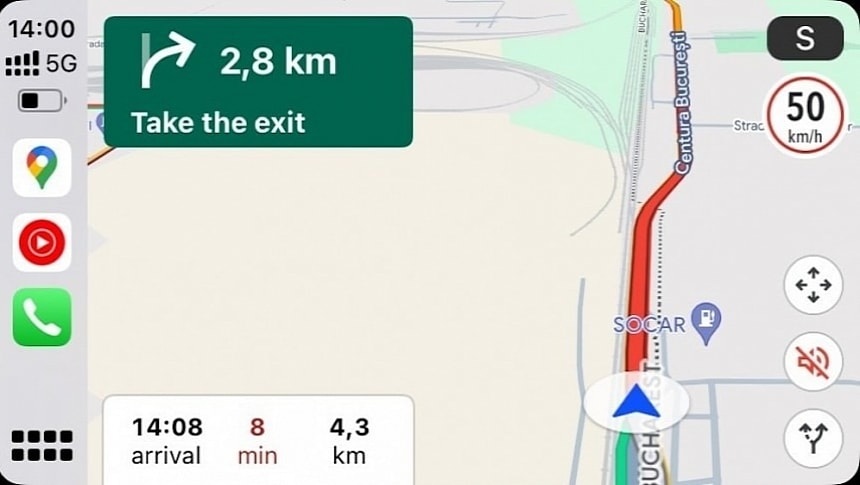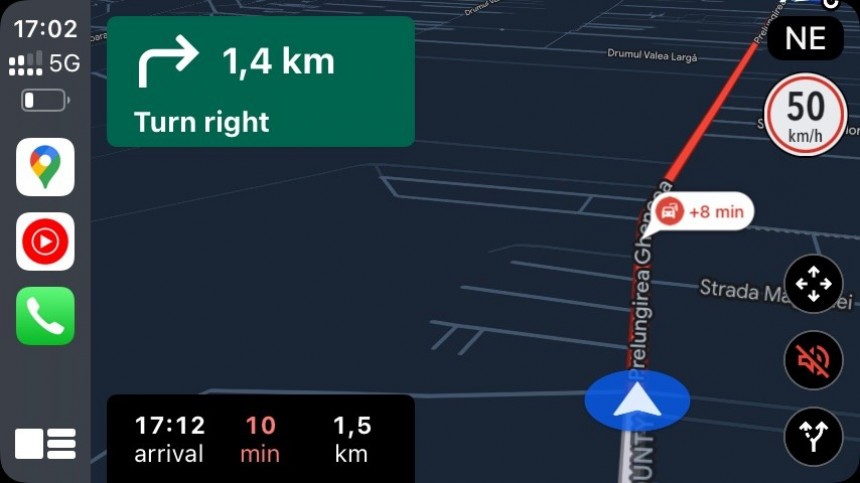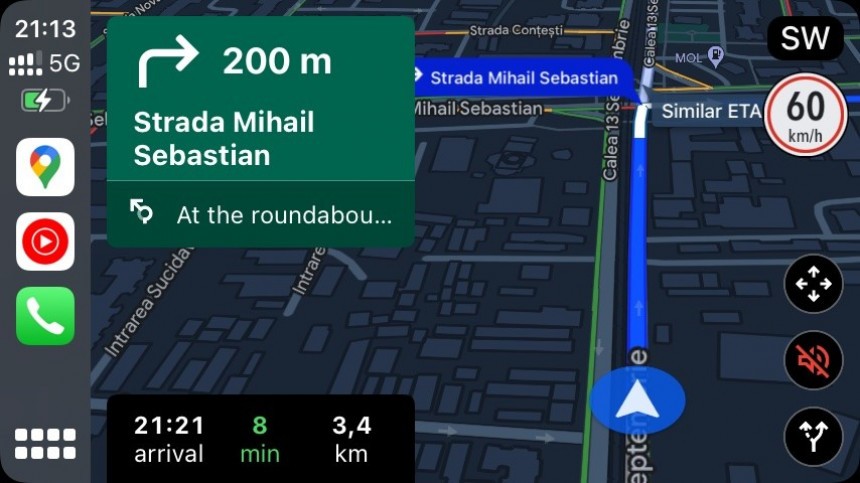Driving to a destination doesn't always have to be a race. While most of us want to arrive as fast as possible, there are times when we just want to enjoy the drive and admire the beautiful scenery around us.
Road trips are the best example. If you leave on a journey with your family, the main goal isn't always to get there as fast as possible but to enjoy the moment, enjoy the buildings, the seacoast, the greenery, and everything else that makes a road trip… a road trip.
This is the reason many people asked Google to update Google Maps with an option for so-called scenic routes.
The application now provides two types of routes to users searching for turn-by-turn guidance: the fastest and an eco-friendly alternative, the latter of which is supposed to improve fuel efficiency and reduce emissions.
A scenic route would look for a more enjoyable way to reach a user-defined destination but guide the driver to roads with famous scenery and architecture. While users have been asking for this feature for years, Google has always ignored the request.
Kasey Klimes, a former Google Maps Senior UX Researcher, recently explained on X (formerly Twitter) why integrating such a feature doesn't make sense.
Klimes starts by highlighting how Google Maps works, explaining that when the service searches for the fastest route between the current location and the destination, it gives every segment of the street network "an equal chance at being travel." This is because the algorithms developed for Google Maps are objective.
This is where the scenic routes would completely change how Google Maps works.
Integrating such a feature in Google Maps changes how the system works, as the application would also have to consider other factors that define a scenic route, including architecture, streets, and trees. With this approach, Google Maps would become biased.
Adopting this approach would lead to what the researcher calls "a feedback loop with spatial inequality." Low-income streets would be directly impacted, as Google Maps would send most users to high-income streets where a scenic route makes more sense.
"Inadvertently diverting foot traffic from low-income streets to high-income streets takes revenue and potentially tax dollars from already struggling communities and funnels it instead to richer communities," the researcher explains.
The good news is that Google actually considered adding a scenic route to Google Maps, and the researcher revealed that only the walking navigation was analyzed. It could still land at some point, as Klimes explains that "technical, this idea is entirely feasible."
Scenic routes have already been integrated into other navigation apps. One of the most popular is Scenic Motorcycle Navigation, an application relying on its community to find and upvote scenic motorcycle routes.
This isn't the only highly requested feature that Google Maps seems to ignore.
A truck navigation mode that would allow drivers to rely on Google Maps for turn-by-turn navigation behind the wheel of a large vehicle, such as a lorry or RV, has long been a top feature request. The search giant never commented on truck navigation support, and while other navigation apps have already integrated such capabilities – such as Sygic – Google continues to focus on guidance for passenger vehicles.
A dedicated truck navigation mode would allow Google Maps to consider more factors when searching for turn-by-turn guidance to a user-defined destination, including the vehicle size, the cargo type and dimensions, road restrictions, and other specifics exclusive to large vehicles.
Unfortunately, many people misuse Google Maps when driving large vehicles, such as lorries, and rely on the app to navigate a destination. Because Google Maps ignores vehicle dimensions, these drivers are sent on routes that are only suitable for standard passenger cars. Due to the larger size, lorries and RVs sometimes get stuck on narrow roads, requiring assistance to return to a suitable road. In some cases, lorries get stuck under bridges, causing massive traffic disruption.
Google never commented on this feature, but lorry and RV drivers should avoid using Google Maps for navigation unless they drive a passenger car. Alternative truck navigation solutions and GPS navigators help them arrive at a destination safer and more conveniently, as these solutions also consider vehicle specifications and include road restrictions for appropriate navigation.
Google's other navigation app, Waze, uses a similar approach, always looking for the fastest route to the destination. It's not suitable for large vehicles and doesn't offer support for scenic routes. Its main selling point is a crowdsourcing engine that allows users to upload traffic reports on hazards like accidents, speed traps, and potholes. Using this information, Waze can generate warnings for other users, giving them more time to slow down before approaching the flagged location.
Compared to Google Maps, Waze does not look for fuel-efficient routes and is entirely focused on getting you from where you are to where you want to be as fast as possible.
This is the reason many people asked Google to update Google Maps with an option for so-called scenic routes.
The application now provides two types of routes to users searching for turn-by-turn guidance: the fastest and an eco-friendly alternative, the latter of which is supposed to improve fuel efficiency and reduce emissions.
A scenic route would look for a more enjoyable way to reach a user-defined destination but guide the driver to roads with famous scenery and architecture. While users have been asking for this feature for years, Google has always ignored the request.
Klimes starts by highlighting how Google Maps works, explaining that when the service searches for the fastest route between the current location and the destination, it gives every segment of the street network "an equal chance at being travel." This is because the algorithms developed for Google Maps are objective.
This is where the scenic routes would completely change how Google Maps works.
Integrating such a feature in Google Maps changes how the system works, as the application would also have to consider other factors that define a scenic route, including architecture, streets, and trees. With this approach, Google Maps would become biased.
"Inadvertently diverting foot traffic from low-income streets to high-income streets takes revenue and potentially tax dollars from already struggling communities and funnels it instead to richer communities," the researcher explains.
The good news is that Google actually considered adding a scenic route to Google Maps, and the researcher revealed that only the walking navigation was analyzed. It could still land at some point, as Klimes explains that "technical, this idea is entirely feasible."
This isn't the only highly requested feature that Google Maps seems to ignore.
A truck navigation mode that would allow drivers to rely on Google Maps for turn-by-turn navigation behind the wheel of a large vehicle, such as a lorry or RV, has long been a top feature request. The search giant never commented on truck navigation support, and while other navigation apps have already integrated such capabilities – such as Sygic – Google continues to focus on guidance for passenger vehicles.
A dedicated truck navigation mode would allow Google Maps to consider more factors when searching for turn-by-turn guidance to a user-defined destination, including the vehicle size, the cargo type and dimensions, road restrictions, and other specifics exclusive to large vehicles.
Google never commented on this feature, but lorry and RV drivers should avoid using Google Maps for navigation unless they drive a passenger car. Alternative truck navigation solutions and GPS navigators help them arrive at a destination safer and more conveniently, as these solutions also consider vehicle specifications and include road restrictions for appropriate navigation.
Google's other navigation app, Waze, uses a similar approach, always looking for the fastest route to the destination. It's not suitable for large vehicles and doesn't offer support for scenic routes. Its main selling point is a crowdsourcing engine that allows users to upload traffic reports on hazards like accidents, speed traps, and potholes. Using this information, Waze can generate warnings for other users, giving them more time to slow down before approaching the flagged location.
Compared to Google Maps, Waze does not look for fuel-efficient routes and is entirely focused on getting you from where you are to where you want to be as fast as possible.



















